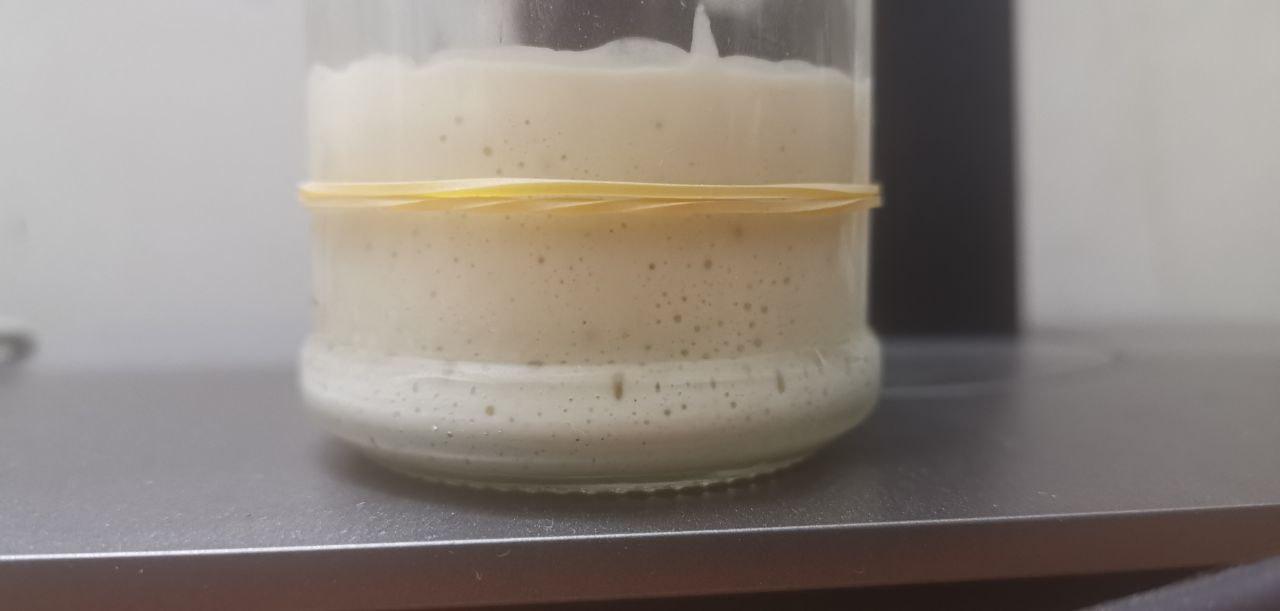This is the starter I made in 5 days to test my theory that traditional starter recipes are flawed in that they, calling for 1:1:1 feeding starting on day 3 (sometimes even for 1:2:2), dilute the starter too much too soon, not letting it get sour enough, cancelling out the single best development for successful starter, that is low pH (or high acidity).
I mixed it at 0:1:1, then waited 48 hours stirring every 12 hours. The mixture progressed as follows:
0h: just mixed - typical consistency for your freshly mixed dough at the start of autolysis
12h: lots of very strong, stretchy gluten, no changes in smell
24h: socks smell
36h: x1.5 increase in volume, socks smell subsided, and gone after stirring
48h: no bad smell at all, smells like youghurt, deflated. That meant that all the Enterobacteria (they are responsible for cheesy, socky smell) are done fermenting and turned into lactic acid. And I expect (or, say, hope) they will not come back thanks to the fact that acidity of the starter doesn't fall to levels they can live at again.
Then I fed the starter at 4:1:1. That dilutes it only by 25% (1 part water to 4 parts starter) keeping acidity high (pH low), but adding some food for whatever organisms can develop at lower pH. And wow, in the next 24 hours starter bubbled, grew somewhat, did not develop funky smell and by the end of the 24 hours developed the proverbial acetic smell which I dread of because this is where my three previous attempts stalled, the nail polish smell would stay again and again during the previous tries with each feed.
2nd feed happened 24 hours later, at 3:1:1. And lo and behold, within the next 24 hours the acetic smell turned into youghurty. And then it turned into yeasty and started growing, with exact smell I wanted. Overall increase was about 1.25x which I attribute to limited feed (food).
3rd feed was done about 18 hours ago, at 2.2:1:1 (or 11:5:5, if you prefer integers). And by now, it has doubled in size, and smells exactly like the mature sourdough I have going for 2 weeks in another jar, raised using Debra's tried and tested method.
And all this was done using regular all-purpose flour, just clean bottled water, no juice, no rye, no salt.
That is a tremendous success, and my experiment proves to me that the yeast and bacteria we need are readily available in the flour, they are not dormant, they are not inhibited in any way by stinky beasties, they don't need waking up, they readily grow once the only condition - low pH, is satisfied. And they are introduced in the 2nd and 3rd feeds, because the 1st one is dominated by the "bad" organisms, including wrong yeast (acid-intolerant ones).
The reason so many attempts at having starter going fail is that we are extending the first 72 hours of this experiment for indefinitely long by diluting the starter and bringing conditions that are detrimental to sourdough, back with every feed. At the end, some succeed, but it happens "despite" and not "thanks to".

I revived one of my stalled starters, which was at its 11th day smelling acetone with no growth, with sometimes 1:2:2, sometimes 1:1:1 feedings every 12 to 24 hours, by a SINGLE FEEDING at 2:1:1.
Once it is going, it develops enough "correct" LAB and yeast, and can withstand diluting feeds easily. But not before.
Do you think this would work as well with a lower water ratio, for those who prefer a thicker starter?
I see no reasons why not but it is so much easier to change hydration once the starter is alive and healthy. Once you bring it up to 5:1:1 ratios, simply feeding with desired hydration couple times will bring the starter to that desired hydration.
In Debra's formula hydration goes from 200% to 100% on the 5th feeding!
I am always up to try a new technique/method/recommendation/theory/adventure. Thanks!
very important
what temperature is the process?
Worked for me at around 20-24c, should be fine up to 30c
According to Debra Wink's writing on the topic, the pineapple juice in the pineapple juice method is to keep acidity high (pH 3.5 for the juice according to the internet), so maybe there is more to this than just keeping the acidity up.
This whole experiment is fully in line with what Debra said (and in fact, it is entirely informed by Debra's research). In her case she feeds it for three days with juice maintaining acidity - and I tried to achieve that without juice by feeding very very little and maintaining acidity gains. The kind of yeast and LAB we need require couple of days to develop and to multiply in quantities that would be sustainable, without the others that would dominate them. And both her method and my experiment facilitate exactly that.
Very interesting, and nice to see your approach.